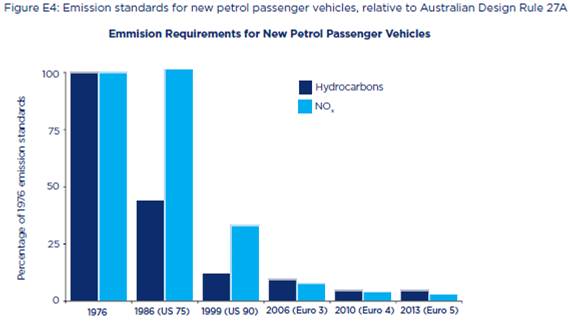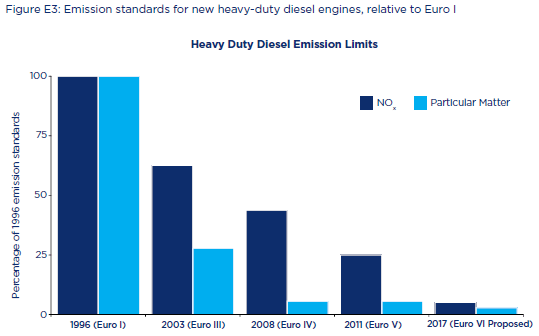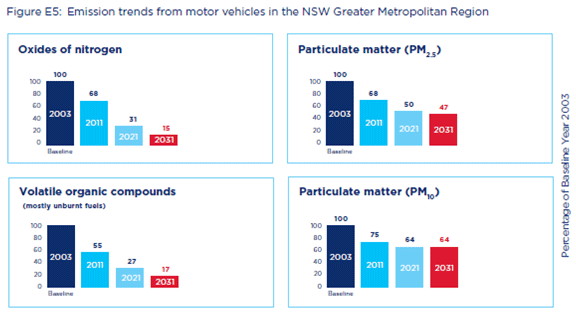
Air pollution and vehicle emissions
Sydney's air quality is good by national and international standards
Sydney's air quality is very good by world standards, according to the World Health Organisation that sets global air quality guidelines. Find out how our air quality levels compare to other major cities and centres around Australia and the world by exploring the air quality portal.
Sydney is a major international centre with a range of sources that contribute to air pollution. In Australia, air pollution is assessed by measuring six main air pollutants:
- carbon monoxide
- nitrogen dioxide
- photochemical oxidants (as ozone)
- sulphur dioxide
- lead
- particles.
Urban air pollution is a known carcinogen and has a range of human impacts. Nitric oxide is not harmful to health at typical ambient concentrations, but nitrogen dioxide can be.
Of all the pollutants assessed, PM2.5 (tiny particles of matter, one‑fortieth the width of a hair) is considered to present the greatest potential impact to our health. No level of air pollution is completely safe for humans, which is why we have such stringent emission reduction strategies in place.
For more information please read the Advisory Committee on Tunnel Air Quality report on Health Effects of Traffic-Related Air Pollution (PDF, 186.92 KB).
Particulate matter (PM) in the air can come directly from natural sources such as bushfires and dust storms. It can also come from human activities such as wood burning, quarrying and mining, motor vehicle use and industrial processes. Particle pollution is evident as the brown haze sometimes seen in the cooler months of the year.
Motor vehicles are a significant contributor to emissions, contributing 14 per cent of PM2.5, and 62 per cent of nitrogen oxides. However vehicle emissions are reducing, and within a global context, Sydney’s air quality is very good.
To find out more about common air pollutants – including standards and sources – download the NSW EPA Substance Information Report (PDF, 403.96 KB).
Vehicle emissions
Motor vehicles are a significant but declining source of air pollution
Despite there being more cars on the road, a number of initiatives and technological developments have resulted in substantial reductions to Sydney’s vehicle emissions over the past two decades.
The number of cars is expected to further increase as the population of Sydney continues to grow, however total emissions from motor vehicles are set to continue to fall over the next decade due to new cleaner vehicles replacing older technology vehicles
Newer vehicles produce significantly less emissions than older vehicles
Better fuels, improved technology and stringent emission standards have contributed to this improvement. For example:
- Cars built since 2013 emit three per cent of the oxides of nitrogen than vehicles built in 1976.
Figure E4 - Emission standards for new petrol passenger vehicles, relative to Australian Design Rule 27A
- Diesel trucks built from 2013 emit eight per cent of the particles emitted by vehicles built in 1996.
Figure E3 - Emission standards for new heavy-duty diesel engines, relative to Euro 1
These figures are expected to continue falling over the next decade (Figure E5), despite projected increases in the number of vehicles in use and the number of kilometres driven.
Figure E5 - Emission trends from motor vehicles in the NSW Greater Metropolitan Region
To find out more about vehicle emission standards, see Emission standards.
Reducing emissions when we drive
Transport for NSW, along with other agencies, has developed and implemented a range of initiatives to reduce the impact of vehicle emissions on air quality in NSW.
Assessing air quality impacts from surface roads
Recognising the contribution of motor vehicles to air pollution, Transport for NSW developed the Tool for Roadside Air Quality (TRAQ). TRAQ assesses the potential air quality impacts and greenhouse gas emissions from vehicles using new or existing roadways.
Find out more information about TRAQ.
Road tunnel air quality
Transport for NSW adheres to strict conditions set down by the NSW Department of Planning and Environment for the maximum allowable presence of vehicle emissions in the air both in and outside its tunnels. These requirements are amongst the most stringent in the world.
Modern tunnel ventilation design ensures sufficient air flows within the tunnel to meet air quality requirements and uses elevated outlets to eject tunnel emissions high into the atmosphere where they disperse and become indistinguishable from background levels. The planning approval requires comprehensive monitoring to demonstrate this. Visit our interactive road tunnels page to find out more.


